Blueberry IPM Post Bloom
Most blueberry cultivars here in Maryland bloomed and green fruit are developing. Now is the time when a variety of pathogens and pest will begin to take up residence in your field which can harm your developing crop. It is important to perform routine scouting throughout your farm and make sure that you’re not seeing symptoms of some of the common pests and pathogens. Below is a description of several of the most common diseases and pests you may find at this time in your blueberries.
Pathogens to be on the lookout for:
During the cool, wet days where temperatures do not reach above 70 degrees, you may begin to see symptoms of several fungal pathogens including botryosphaeria canker or stem blight, botrytis, anthracnose, and powdery mildew. These conditions make for an ideal environment for some of these fungal pathogens to grow or spread.
Botryosphaeria stem blight
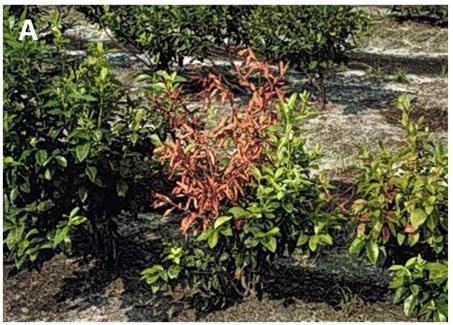
Botryosphaeria stem blight (Figure 1A) will exhibit dieback symptoms. It is initially detectable as yellowing and reddening of leaves which will move down then stem as vascular tissue becomes blocked by the pathogen. Whereas, botryosphaeria canker will develop as stem lesions which will sometime become swollen resulting in the formation of a canker. If botryosphaeria stem blight or canker is observed the best method to prevent the spread is pruning the infected tissue and fruit clusters six inches below any infected stems. Then, remove pruned branches from the field.
Botrytis
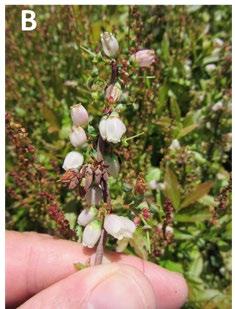
Botrytis (Figure 1B) also known as gray mold, affects both fruit and the plant. It infects the fruit from bloom. As with botryosphaeria, the best tactic to reduce the spread of this disease is by pruning out infected fruit clusters and wood, then removing clippings from the field.
Anthracnose
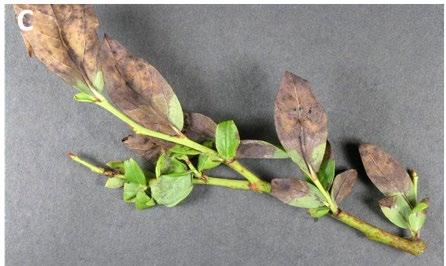
Anthracnose (Figure 1C) will appear as stem, bud, and leaf lesions and may have orange spore masses. Infections will cause leaf browning and will move from the top of the leaf to the bottom. If untreated, anthracnose will also cause fruit rot. Fungicides may be used to prevent the further development of anthracnose during the green fruit development stage.
Powdery mildew
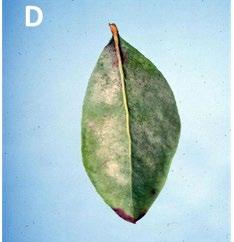
Powdery mildew (Figure 1D) will start as chlorotic discoloration spots and develop into powdery masses on leaves. The
infection usually begins in the spring with young leaves and may become more severe throughout the season eventually causing defoliation. However, while unsightly, powdery mildew will not significantly damage the developing fruit crop and therefore no action is required.
Pest to watch out for:
As green fruit begins to color there are some key pests that should be identified and if detected a spray schedule should be devised. These pests include cranberry fruitworm, cherry fruitworm, plum curculio, and oriental beetle.
cherry fruitworm
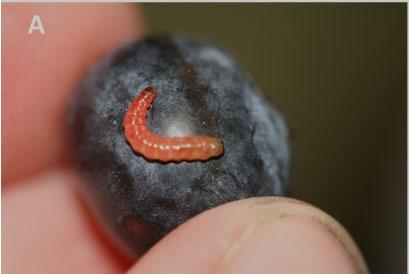
The cherry fruitworm (Figure 2A) will begin laying eggs soon after petal fall of fruit directly on the calyx. The eggs are smooth and flat and will develop into larva which may begin to eat through developing berries. The larva will have a distinct pink color with a red head which differentiates them from the cranberry fruitworm.
cranberry fruitworm
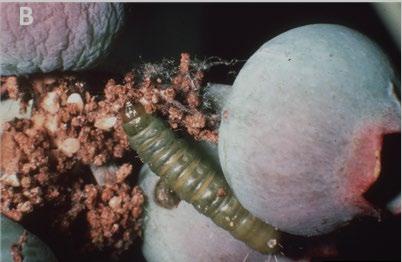
The cranberry fruitworm (Figure 2B) are the larvae of moths that begin laying eggs as soon as green fruit has formed. Damaged fruit will retain a small pin prick hole and may shrivel before reaching maturity. Upon the larva hatching, a frass trail of silk will be left and fruit will be damaged.
Plum curculio
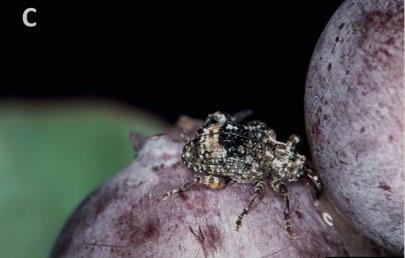
Plum curculio (Figure 2C) will also oviposit into developing green fruit leaving behind a sometimes raised half-moon scar on infested fruit. The developing maggots inside of infested fruit will cause premature fruit drop or shriveling of the berry.
oriental beetle
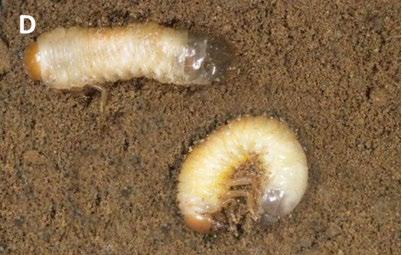
The adult oriental beetle looks similar to the Japanese beetle but tends to be a lighter bronze over their wing covers. In the spring the larvae (Figure 2D) will begin to eat the roots of newly planted blueberries. Later in the season, Larvae will develop into adults which will cause minor injury on leaves. Thus, larvae of the oriental beetle are more of a pest because they can cause severe damage to the overall health of the plant compared to the adult form.
Insect traps may be helpful to identify adult forms of these pests. If any of these pests or pest damage is identified among your blueberries take necessary action in the form of targeted insecticides to prevent further damage.